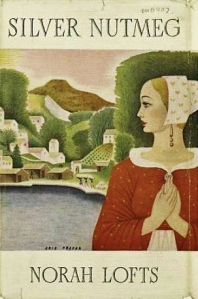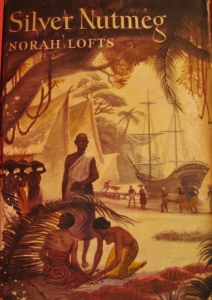 A Footman for the Peacock by Rachel Ferguson ~ 1940. This edition: Dean Street Press, 2016. Softcover. ISBN: 978-1-911413-71-4. 206 pages.
A Footman for the Peacock by Rachel Ferguson ~ 1940. This edition: Dean Street Press, 2016. Softcover. ISBN: 978-1-911413-71-4. 206 pages.
My rating: 8/10
Ever since my 2012 reading of Rachel Ferguson’s challenging but ultimately enjoyable 1931 novel, The Brontës Went to Woolworths, I’ve harboured a yen to broaden my exploration of the further works of this highly intelligent (and highly class conscious) writer.
Imagine then my anticipatory pleasure when approached by Dean Street Press with a review copy of one of Rachel Ferguson’s long out-of-print novels, A Footman for the Peacock, a partly serious, partly fantasy, partly satirical novel set at the beginning of the Second World War.
“Yes, please!” was my response, and I must say in this case my instinct that this was going to be a pleasure to read and review was perfectly correct.
A small aside, here, regarding my book reviewing. As a book blogger in this esoteric corner of the internet, I frequently receive requests to read and review things, and I generally turn these requests down. No time or energy for possible duds, you know. (I find enough of those for myself quite voluntarily!)
Unless the book in question is one which looks to be something I’d be interested in buying for myself in any event, in which case I’m naturally as keen as can be. (Re-publishers of mid-century middlebrow fiction, and gardening and travel books of any era, please take note! 🙂 )
Back to the Peacock.
It’s 1939, and the war is looming. Even the most optimistic of “peace in our time” Munich Agreement yes-men have come to the realization that all of that was a great big political farce, and that the guns will soon be firing.
The aristocratic Roundelays are in residence at Delaye, a vast pile of a country house just barely holding its own as the 20th century brutally takes its financial toll on the English “gentleman’s class”. Sir Edmund and Lady Evelyn know that another war is well-nigh inevitable, but in concert with their rural neighbours are merely holding still, making no actual preparations other than mental, because to do so would break the fragile hope that peace might yet prevail.
The Roundelays are walking a financial tightrope, balanced as they are between the still-wealthy and the newly bankrupt; each breath of political wind sends them swaying, but they refuse to step aside and are making shift to keep things going, with ever-fewer servants and not running a car (Lady Evelyn does the household shopping herself, travelling to and fro by bus) and having a cousin in residence as a paying guest, his five guineas a week going directly into the grocery budget for cousin Maxwell, Lady Evelyn, Sir Edmund, their two daughters still at home, three perennially feuding great-aunts, an ancient and increasingly senile old family retainer (Nursie), long-time dedicated butler, cranky cook, and a gardener, his helper, and a housemaid or two, not to mention kitchenmaid Sue Privett, eighth in her family to have been in service to the Roundelays, which turns out to have great significance to our story.
And there’s the peacock.
Ill-tempered, raucous, and tolerant only towards kitchenmaid Sue and the younger Roundelay daughter, Angela, the peacock haunts the grounds of Delaye, finding his way home after being forcibly relocated to a neighbouring estate where it is hoped he will find solace with a flock of peahens.
We have clues early on that this particular peacock is much more than a semi-domestic bird. He is, instead, a sort of reincarnation of long ago Roundelay servant Thomas Picocke, a “running footman”, who perished in 1792 due to the horrific nature of his duties (running in front of the carriage horses for miles and miles, to clear the way and announce the arrival of his masters) and the callous disregard of the family he served; all but French expatriate Lady Marguerite, wherein lies a sad tale of pity and betrayal, but not that which you might think…
Of reincarnations we have an inkling of three in this complex tale; also an intriguing reference to Dunne’s Theory of Time, a concept of serialism, or parallel streams of time, much discussed by the intellectuals of Rachel Ferguson’s time, and used by such disparate writers as J.B. Priestley, Rumer Godden and Elizabeth Goudge in their novels.
A Footman for the Peacock was received with lukewarm enthusiasm upon its publication early in the war. Though Rachel Ferguson was well-known by that time as a cutting satirist, the portrayal of the Roundelays as self-devoted shirkers of wartime duties grated just a bit too much on the sensibilities of reviewers, who suspected that Rachel Ferguson’s tongue was not quite as far in cheek as it should have been.
Here’s a sample of what got on their nerves.
War has just been declared, and the Roundelays are appalled by the thought of taking in evacuees or refugees. -(Perhaps understandably so, for their domestic arrangements are delicately balanced at the extreme edge of manageability – though others less well-placed are turning their households inside out in the service of the National Emergency, so that’s not a real excuse.) Anyway, at dinner one night, eldest daughter Margaret drops a bit of a conversational bomb.
‘I say, mother, I had a letter yesterday from Ortrud Bohm, that German girl I was at school with – ‘
Lady Roundelay smote the table with her fist. ‘No! No she doesn’t! My heart bleeds for the German Jews as much as anybody’s but I cannot face a pale fugitive running tear-stained in what she stands up in down this avenue. I’ve read horrors until I’m sick and I know everything the Nazis have done and I can’t cope with being wept over and having the old home in Hamburg or wherever it is described brick by brick and hearing that Mein Vater was suddenly not there and hasn’t been seen since, and that the Liebe Mutter was raped before her eyes and my German wouldn’t stand the strain. I can only say Bitte and Danke Sehr and Sauerkraut and Mein Kampf, and I won’t, I won’t, I WON’T!’
‘God, no,’ confirmed Sir Edmund. ‘If she comes, I go.’
Margaret finished her ham. ‘I was only going to tell you what she wrote and she’s not Jewish, you know… She says that she’s joined the Youth Movement and her brother’s in the army and he’s got a commission he couldn’t have hoped for in peace time as the Bohms aren’t geboren, you know, and that they’re not half so sniffed at as they used to be when they were only in trade, and she’s really seeing some men at last and is having the time of her life. She actually used some German words, so that really looks as though she might even marry now she sees it’s no good being so frightfully British. She was the one who came into the class once in a tartan skirt.’
‘Gosh… well, sorry I spoke. I hope she hooks some oberleutnant – what happened in church today, aunt Jessie?’
Did you find this passage rather shocking?
Well, you were supposed to, because Rachel Ferguson’s point is that people are a mix of thoughts, feelings and instinctive responses.
Quite “nice” people like the Roundelays – who are loving parents (the relationship between Lady Evelyn and emotionally fragile daughter Angela is one of the most likeable aspects of this all-over-the-place book), relatively decent to their servants (that episode with the running footman being in the bad old past), kindly dutiful to their tiresome relations and dependents (the great-aunts and Nursie are high maintenance to the nth degree) – I repeat, quite nice people in comparison to the society they exist in, harbouring selfish and bigoted thoughts, and having the temerity to voice them out loud.
In the last lies the rub.
For though we all harbour certain best-not-spoken thoughts, the Roundelays let fly. Mostly in the family circle, but we are privy to their words, and we recoil in politically correct horror to what is expressed in passages such as the one above, while guiltily holding in laughter, because a lot of what is said is (full disclosure – I laughed when I read this) very funny.
There is a strand of plot running through this very full story, but much of the pleasure of the thing lies in the many side excursions – show Rachel Ferguson a glimpse of a rabbit trail and she’s off like a shot, returning to the main path not at all winded and blithely assuming her reader to be loping along still in stride.
It takes a bit to get it figured out, but once one is hooked – it took me about 20 pages or so; I went back and checked – the rest of this quirky novel is both thought-provoking and entertaining. It’s occasionally rather like untangling a mess of yarn complete with helpful kitten, but it works.
And, thanks to Dean Street Press and the republishing of not just this one Rachel Ferguson novel, plus two more and a tempting selection of other mid-century reprints, my Christmas book wish-list for myself is well-nigh complete. Check out their recent releases – oh, bliss! Available as paper books (print on demand, and very nicely done; I’m impressed) from the publisher or via Amazon and Book Depository; also as ebooks in various formats.
For the original book blog review which triggered this reprint, I’m going to send you over to Scott of Furrowed Middlebrow, whose impeccable taste in obsolete fiction has pointed the way to many, many hours of excellent reading.
Here’s his take on A Footman for the Peacock, with loads of quotes and a most thoughtful analysis, which I find myself nodding away to in complete agreement.
Read Full Post »
 Bath Tangle by Georgette Heyer ~1955. This edition: Heinemann, 1955. Hardcover. 327 pages.
Bath Tangle by Georgette Heyer ~1955. This edition: Heinemann, 1955. Hardcover. 327 pages.























